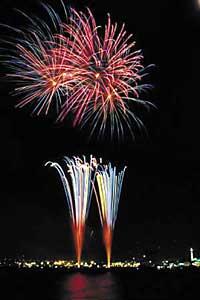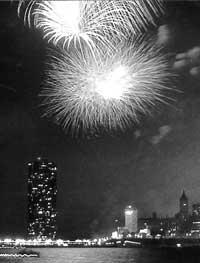Colorful summer show
2002/07/01 Mendiburu, Joana - Elhuyar Zientziaren Komunikazioa Iturria: Elhuyar aldizkaria
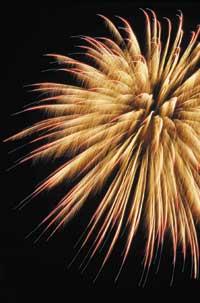
The bright colors produced by fireworks, noise and spectacle are for many one of the main exponents of the festival. But the shows also blind, the spectator is not aware of the infrastructure of the show and in the case of rockets it happens like this: behind those lights and explosions there is a simple structure and precise mixes.
Uses throughout history
The rocket is of Chinese origin. Black powder or at least gunpowder was first used in it, VIII. and IX. around the centuries. In Europe, XIII-XIV. It appeared towards the 20th century.
During the Middle Ages, during the war, they were not used to set fire, but to scare the horses. To increase this effect, the XVI. At the end of the 20th century, rockets were filled with firecrackers and grenades, an idea that was later discarded. Moreover, due to the difficulty of determining the direction of the rockets, they were completely discarded for a long time. However, it seems that they were widely used during the First World War and, as has happened with other materials and technologies, today they are mostly used for celebrations, the excuse for developing rockets has been war.
Structure of fireworks
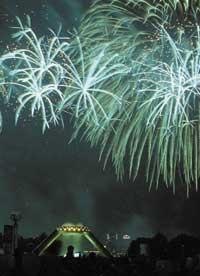
Most fireworks have only two compartments. The lower one, which is in contact with the wick, is filled with gunpowder, and in the second are inserted the elements that will create the show when exploding. Fireworks with more compartments happen with more than one explosion.
The gunpowder, when burned, secretes a lot of gas and moves the rocket to the height at which it explodes. The gas leaves the holes prepared for it, which makes the rocket move. Gunpowder does not extend much, is not very toxic and is very stable in areas without moisture, so it is used so much.
Once burned, to prevent them from colliding with the church bell, the holding rockets in a straight direction carry a stick.
As soon as the gunpowder is burned, the rocket starts at full speed in the sky until it explodes sharply. Then, for the enjoyment of the smallest and largest of the house, the sky is decorated with bright colors and all kinds of shapes. In some cases, bright luminosity and high noise occur. These are the characteristics of fireworks: brightness, color, shape and noise.
Illuminating the sky
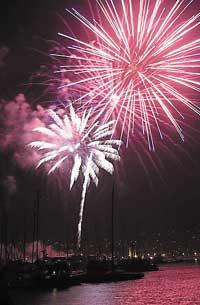
Fireworks produce light by two phenomena, but in both cases redox reactions occur. That is, an oxidizer oxidizes another compound. These reactions need oxygen, but in the case of fireworks do not consume oxygen from the air. The oxidizers used are usually oxygen-rich metallic salts such as nitrates, chlorates and perchlorates.
The phenomena generating light are incandescence and atomic emission. Incandescence is simply the property of matter to emit light by high temperatures. However, it is worth mentioning a small detail: the emitted light is proportional to the temperature, that is, the granulate. Therefore, with a slight increase in temperature you get much more light.
This is the case of magnesium. The metallic oxide particles generated in the oxidation of the fuel rise to temperatures above 3,000 °C, generating sufficient luminosity to dazzle the incandescence.
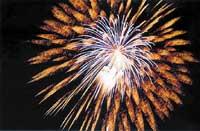
However, producers rely on atomic emission to obtain the bright color of current fireworks. Behind this technical name there is a relatively simple event, on whose basis are the electrons.
The electrons are located around the nucleus of the atom, arranged staggeringly according to their energy. When they absorb energy from an external energy source, in which case heat is the energy source, they jump to the next energy level. To move from one level to another, as if the stairs were rising, electrons need energy and cannot be halfway to two steps. However, the new energy level is normally not stable and the electron will quickly return to the initial energy level. But in all this, where is the light?
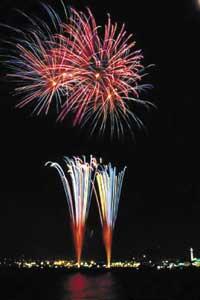
When the electron drops to the basic energy level, it releases that energy difference as light. Depending on the atom, the difference between energy levels will be higher or lower, so electrons will not release the same amount of energy.
Light converted into color
But the purpose of the fireworks is not to illuminate the sky, but to seduce the viewer, and for this they must decorate the sky with bright colors. But is there a relationship between light and colors? And how are colors created?
Colors are sensations that produce light and, therefore, to know how colors are produced, first you have to know what is light
Light is an electromagnetic wave that is defined according to two parameters: frequency and wavelength. Compared to the waves that explode on the beach, the frequency would be the number of waves arriving in a limited time and the wave distance between one wave and the next. The higher the energy, the lower the wavelength of light.
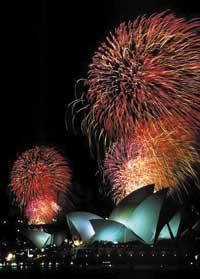
The human eye does not see all wavelengths, it only sees between 400 and 800 nm approximately and each length corresponds to a color. The ubela is the lowest wavelength color that can be seen by the human eye (380 nm) and red the longest wavelength (780 nm). The waves between these lengths correspond to blue, green, yellow and orange. The target is obtained by emitting waves of different length at the same time.
Depending on the components used for the manufacture of artificial fire, waves of different length will be obtained. For example, if you want to make green artificial fire you will use the barium. Specifically, at the time of the explosion a barium chloride (BaCl 2) must be generated, a compound that produces waves of an approximate length of 500-530 nm, which is corresponding to the green.
It's easier than getting it! This is because, in case of excess oxygen, instead of forming barium chloride, barium oxide (BaO) will occur that will produce waves of 480-600 nm. These wavelengths give colors from blue to green to orange. These colors can be very beautiful, but they are far from the green that was wanted at first.
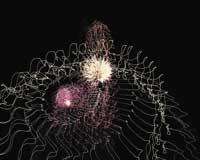
Sodium atoms generate one of the longest waves by atomic emission. When heated to more than 1,800 °C, these atoms create an intense yellow-orange color. The vitality of this color covers the rest of the colors that can be produced at the same time.
To achieve the colors accurately it is necessary to use the components of each of them, but in addition it is necessary to control redox reactions very well to avoid the formation of unwanted molecules.
Losing in ways…
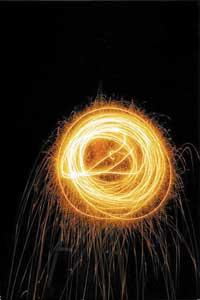
In addition to the colors, spectators are fascinated by the shapes: water slides, palm trees, comets, streamers… Depending on the ingredients and structure, they can be formed in all shapes. But they all rely on the principle that fireworks need maximum energy in as little space as possible.
One of the most well-known forms is that of the palm that closes the fireworks sessions. The palm has bags full of a pyrotechnic mixture called ‘star’. Depending on the location of these bags different shapes will be created.
There are also a variety of fireworks. Exploding each compartment turns on a device that causes a delay that explodes the next compartment. This allows more than one explosion to occur in a single rocket.
On the other hand, the duration of sparks varies depending on the size of particles of artificial fire. If you want the light to stay for a long time, just use large particles, which will stay warmer and the combustion will advance with the oxygen of the air.

If someone believed that the colors and shapes of fireworks are obtained by chance, from now on it will be clear that in the liver there are phenomena of combustion and light emission, components and well worked structures.
Once you know the hidden parts of the fireworks, you just have to look at the sky and enjoy the show they offer.
Nitrate Potassium Chlorate
KNO 3 KCIO 3
Azula420-460 nmCopper Zinc
Copper
Chloride(I)
Copper
Sulfate(II) CineCuSO 4 ZnVerdea520-560
Bnitrate
Chlorine Barium
Well (NO 3) 2
BaCI 2
Ba(CIO 3) 2
oxalate Sodium oxide Sodium nitrate
Na 2 C 2 O 4 Na 2 O
NaNO 3 Magnesium hawthorn 600-620 nmCalcium Calcium nitrate Ca(NO 3)
2 Reddish white
680-780 nmExtraccio aluminum
nitrate
Stirrup
nitrate
Fireworks Black Dot Fireworks can be spectacular, but unfortunately they are also responsible for the pollution that the human eye does not see. In fact, a study conducted in Delhi (India) last fall has shown that fireworks are one of the causes of the greenhouse effect (O 3). Ozone is a secondary pollutant, i.e. it is not emitted directly into the atmosphere. It occurs when nitrogen oxides and volatile organic compounds react under solar radiation. But, as already indicated, it can also be due to fireworks. Fireworks use oxygen-rich metallic salts such as perchlorates, strontium, nitrates and chlorates. Much of the light generated by burning these salts has a wavelength of less than 240 nm (although the human eye does not see it) and the radioactive energy of these emissions is sufficient to dissociate atmospheric oxygen molecules and form oxygen atoms. Oxygen molecules are then linked to newly formed oxygen atoms and ozone is formed. |

Gai honi buruzko eduki gehiago
Elhuyarrek garatutako teknologia



